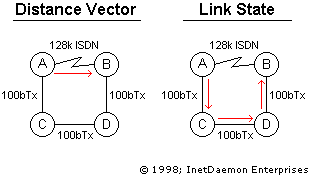DISTANCE VECTOR
- Distance
- Distance is the cost of reaching a destination, usually based on the number of hosts the path passes through, or the total of all the administrative metrics assigned to the links in the path.
- Vector
- From the standpoint of routing protocols, the vector is the interface traffic will be forwarded out in order to reach an given destination network along a route or path selected by the routing protocol as the best path to the destination network.
Distance vector protocols use a distance calculation plus an outgoing network interface (a vector) to choose the best path to a destination network. The network protocol (IPX, SPX, IP, Appletalk, DECnet etc.) will forward data using the best paths selected.
Common distance vector routing protocols include:
Advantages of Distance Vector Protocols
- Well Supported
- Protocols such as RIP have been around a long time and most, if not all devices that performrouting will understand RIP.
LINK STATE
Link State protocols track the status and connection type of each link and produces a calculated metric based on these and other factors, including some set by the network administrator. Link state protocols know whether a link is up or down and how fast it is and calculates a cost to 'get there'. Since routers run routing protocols to figure out how to get to a destination, you can think of the 'link states' as being the status of the interfaces on the router. Link State protocols will take a path which has more hops, but that uses a faster medium over a path using a slower medium with fewer hops.
Because of their awareness of media types and other factors, link state protocols require more processing power (more circuit logic in the case of ASICs) and memory. Distance vector algorithms being simpler require simpler hardware.
A Comparison: Link State vs. Distance Vector
See Fig. 1-1 below. If all routers were running a Distance Vector protocol, the path or 'route' chosen would be from A B directly over the ISDN serial link, even though that link is about 10 times slower than the indirect route from A C D B.
A Link State protocol would choose the A C D B path because it's using a faster medium (100 Mb ethernet). In this example, it would be better to run a Link State routing protocol, but if all the links in the network are the same speed, then a Distance Vector protocol is better.


Post a Comment